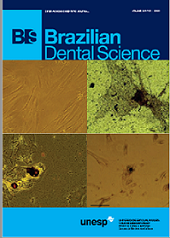Fracture load of nano-ceramic composite material for anterior endocrown restorations
DOI:
https://doi.org/10.14295/bds.2020.v23i1.1853Resumo
Objective: To evaluate ability of Nano Ceramic Composite endocrown to withstand occlusal forces when used in the anterior region. Material and Methods: Eighty endodontically treated maxillary central incisors teeth were randomly divided into two main groups according to the restoration type. 40 of these teeth were post, core and crown restorations and 40 were endocrown restorations. Then they were divided by halves into two subgroups according to the material used 20 were made with Lava Ultimate and the other 20 with IPS e.max. Each subgroup was then further subdivided into two divisions according to the remaining tooth structure above the CEJ (n=10): 2 mm and 0.5 mm above the CEJ. After teeth preparation, the restorations were all made by CAD/CAM system (Cerec MCXL). All samples had undergone cyclic fatigue testing, and then loaded to fracture using a universal testing machine. The specimens were measured and statistically analyzed using Mann-Whitney test for comparing the mean changes between the groups. Results: Lava Ultimate showed higher mean fracture load values than IPS e.max specimens. Conclusion: Endocrowns were found to be more favorable when used on endodontically treated teeth than the conventional post, core and crown restorations.
KEYWORDS
Endocrowns; All-ceramic; Fracture; Cyclic loading.
Downloads
Downloads
Arquivos adicionais
Publicado
Como Citar
Edição
Seção
Licença
TRANSFERÊNCIA DE DIREITOS AUTORAIS E DECLARAÇÃO DE RESPONSABILIDADE
Toda a propriedade de direitos autorais do artigo "____________________________________________________________________" é transferido do autor(es) para a CIÊNCIA ODONTOLÓGICA BRASILEIRA, no caso do trabalho ser publicado. O artigo não foi publicado em outro lugar e não foi submetido simultaneamente para publicação em outra revista.
Vimos por meio deste, atestar que trabalho é original e não apresenta dados manipulados, fraude ou plágio. Fizemos contribuição científica significativa para o estudo e estamos cientes dos dados apresentados e de acordo com a versão final do artigo. Assumimos total responsabilidade pelos aspectos éticos do estudo.
Este texto deve ser impresso e assinado por todos os autores. A versão digitalizada deverá ser apresentada como arquivo suplementar durante o processo de submissão.




























